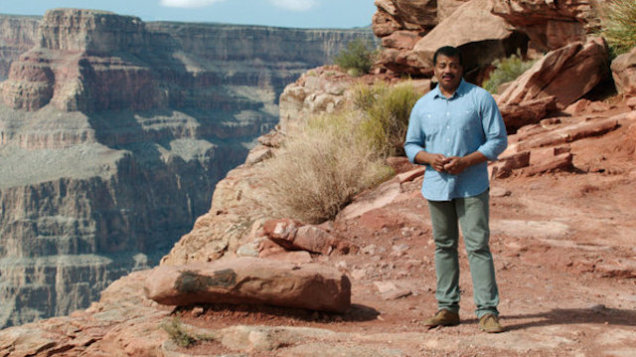In last Sunday's Cosmos episode, “The Clean Room,” Neil deGrasse Tyson gave one of the most detailed and compelling explanations of how we know the age of the Earth. This predictably made some creationists grumpy.

The age of the Earth is an issue that divides creationists into several camps. While creationists universally disparage the theory of evolution, creationist views about the age of the Earth are more nuanced. The intelligent design advocate Stephen Meyer, of the Discovery Institute, was directly asked about his views of the age of the Earth when testifying at state school board hearings in Texas (2009) and in Kansas (2005). In both cases he affirmed that he understood the Earth to be billions of years old, though he did so by using oddly hesitant language and declaring that questions about his views were a “transparently obvious strategy” to impeach his credibility.
Likewise, Hugh Ross, an old-earth creationist with Reasons to Believe, holds that “the Bible is 100% without error,” yet the “days” referred to in Genesis were long periods of time, rather than 24-hour spans. This “day-age” view allows for both a version of Biblical literacy and the validity radiometric dating. Reasons to Believe’s FAQ says,
All dating methods have certain limitations, but when methods are applied in their proper context they yield accurate and reliable results within specified margins of error.
In other words, this creationist group thinks the Earth is 4.5 billion years old. And they are not alone. Williams Jennings Bryan, who helped prosecute John Scopes for teaching evolution, had this to say about the age of the Earth:
I think it would be just as easy for the kind of God we believe in to make the earth in six days as in six years or in 6,000,000 years or in 600,000,000 years. I do not think it important whether we believe one or the other.
Unfortunately, many other creationist groups are not so reasonable. The Institute for Creation Research in Texas has published two ponderous tomes as part of their “R.A.T.E.” project (“radioisotopes and the age of the Earth”). These dense books‒filled with equations and numbers to give them a science-y feel‒argue that scientists’ understanding of radiometric dating is flawed and hence the age of the Earth must be “thousands…not billions” of years.
Answers in Genesis runs the Creation Museum in Kentucky, where the scientific understanding of the age of the Earth is a prime target. One exhibit in the Creation Museum called “Culture in Crisis” shows a wrecking ball smashing the foundations of a church. The wrecking ball is labeled “millions of years.” (I wonder if AiG has heard about Miley Cyrus; her “Wrecking Ball” video might have made a better choice as an example of cultural decay.)
In a blog post on the Answers in Genesis website, Elizabeth Mitchell compared radiometric dating to a “house of cards” because of “numerous unverifiable assumptions.” She claims that Neil deGrasse Tyson knowingly shared “flawed and incomplete information” and made “claims that have been proven incorrect.” But worst of all,
Tyson says we have now turned away from the Bible’s “authoritative” history to “another book” that is “written in the rocks themselves.”
Uh oh. There go those pesky geologists again, always undermining the authority of the Bible with their Brunton compasses and Munsell color charts. That certainly seems to be the Answers in Genesis interpretation. But nothing in the Bible actually talks about the fundamental principles of geology‒or of physics, chemistry, biology, astronomy, or calculus. That is simply not what is in the book, as should be readily apparently to even a casual reader.
If we can get away from this root problem of misusing a religious book as if it were a science text, we can clearly see that the age of the Earth should not be so controversial. Indeed, the age of the Earth is so well established that, as we have seen, even many Bible-believing creationists accept an Earth that is billions of years old.
Yet so pervasive are the misunderstandings of science that numerous polls show significant portions of the American public thinking the Earth is less than 10,000 years old. A 2013 Gallup poll, for example, found that, “Forty-six percent of Americans believe in the creationist view that God created humans in their present form at one time within the last 10,000 years,” and a 2014 Associated Press poll found 36% of respondents “not too or not at all confident” in a 4.5 billion year-old Earth.
Neil deGrasse Tyson’s great work in Cosmos may, one hopes, increase confidence in understanding the clear science used to determine the age of the Earth.
